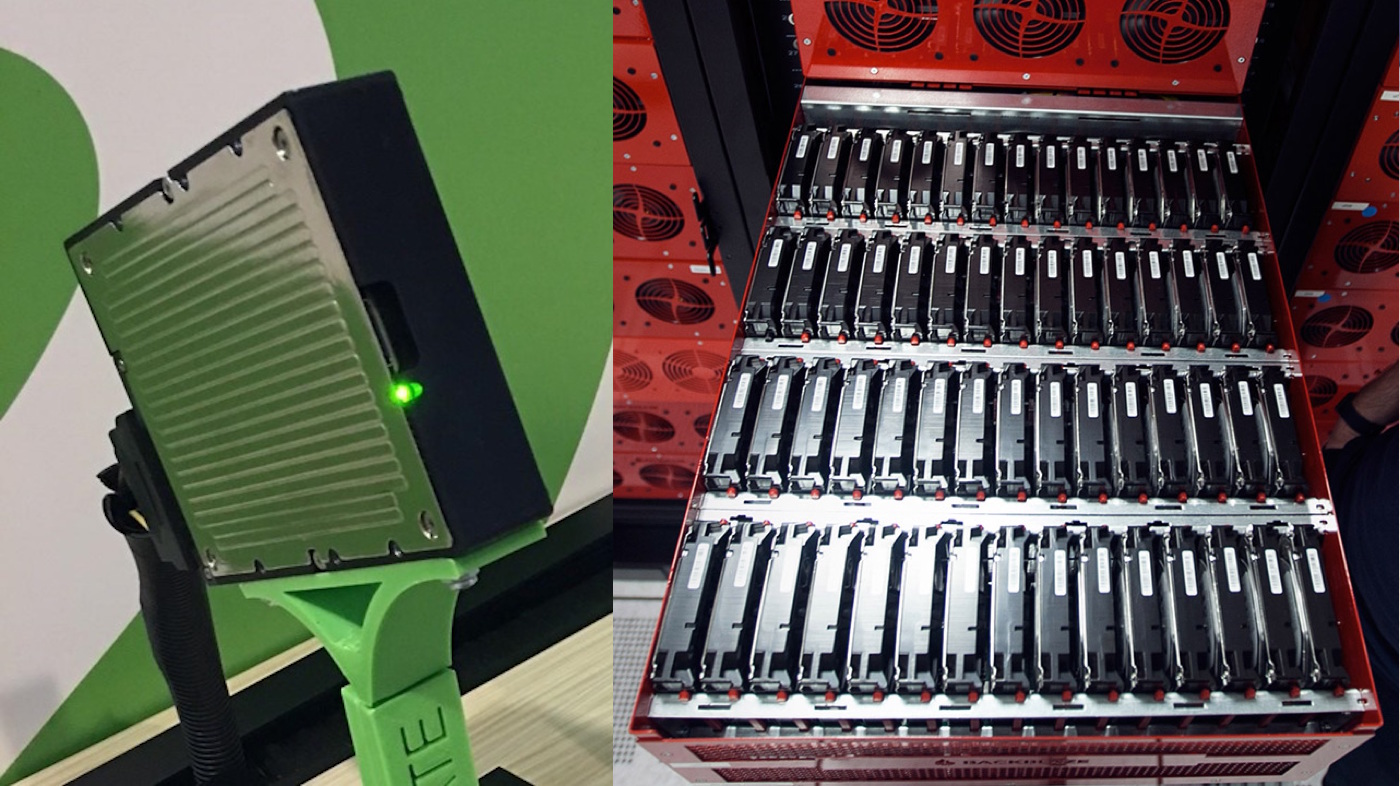Seagate just introduced a 60TB SSD. Wow. As Backblaze scurries about upgrading from 2TB to 8TB hard drives in our Storage Pods, we just have to stop for the moment and consider what a 3.6PB Storage Pod would look like and how much it would cost. Let’s dive in to the details…
What We Know About the Seagate 60TB SSD
A number of sources (Engadget, Computerworld, Mashable, and Tom’s Hardware, to name a few) covered the news. From the Backblaze Storage Pod point of view, here are some important things to know. The Seagate 60TB SSD comes in a 3.5-inch form factor. It uses a 12 Gbps SAS interface and consumes 15 watts of power (average while active). There are a few other fun facts in the articles above, but these will work for now as we design our hypothetical 3.6PB Storage Pod.
What We Don’t Know Today
We don’t know the price. Seagate is calling this enterprise storage, which in Backblaze vernacular translates to spending more money for the same thing. Let’s see if we can at least estimate a list price so we can do our math later on. We’ll start with the Samsung 16TB SSD drive, recently introduced. As they make their way to the market, their price is roughly $7,000 each. Using that number, simple math would get us a price for the Seagate 60TB drives to be $26,250. That seems high, even for enterprise storage, so let’s give a discount of 25% for scalability, bringing us to $19,687.50 each. Applying marketing math, I’ll round that up to $19,995.00 each Seagate 60TB SSD. That’s as good a WAG as any, let’s use that for the price.
Our 3.6PB Storage Pod Design
The most economical way for us to proceed would be to use our current 60-drive chassis (Storage Pod 6.0) with as few modifications as possible. On the plus side, the Seagate 60TB drive has a 3.5” form factor, meaning it will fit very nicely into our 60-drive Storage Pod chassis. On the minus side, we currently use SATA backplanes, cables, and boards throughout, so there’s a bit of work switching over to SAS with the hard part being 5-port SAS backplanes. In a very quick search, we could only locate one 5-port SAS backplane and we weren’t sure it was being made anymore. Also, we’d need to update the motherboard, CPU, memory, and probably convert to 100Gb network cards, but since these are all readily available parts, that’s fairly straightforward (says the guy who is not the designer).
We do have the time to redesign the entire Storage Pod to work with SAS drives given that Seagate doesn’t expect to deliver the 60TB drives until 2017, but before we do anything radical, let’s figure out if it’s worth it.
Drive Math
Currently, the Seagate 8TB drives we use (model: ST8000DM002) today lists for $295.95 on Amazon. That’s about $0.037/GB or $37/TB. Using our $19,995 price for the Seagate 60TB SSD, we get about $0.333/GB or $333/TB. That’s nine times the cost, meaning a 60-drive Storage Pod filled with the Seagate 60TB drives would cost $1.2 million each.
Let’s look at it another way. The Seagate 60TB drives give us 3.6PB in one Storage Pod. What would it cost for us to have 3.6PB of storage using just 8TB hard drives in a Storage Pod? To start, it would take roughly 7.5 Storage Pods full of 8TB drives to give us 3.6PB. Each 8TB Storage Pod costs us about $20,000 each, or $150,000 for the 7.5 Storage Pods needed to get us 3.6PB. Since we can’t have a half of a Storage Pod, let’s go with eight Storage Pods at a total cost of $160,000, which is still a bit lower than the $1.2 million price tag for the 60TB units.
What about the increase in storage density? In simple terms, one rack of Storage Pods filled with 60TB SSDs would replace eight racks of storage using the 8TB Storage Pods. I won’t go into the details of the math here, but getting eight times the storage for nine times the cost doesn’t work out well. Other factors, including the 70% increase in electrical draw per rack, make the increase in storage density currently moot.
If You Build It…
There is one more thing to consider in building a Storage Pod full of Seagate 60TB drives: Backblaze Vaults. As a reminder, a Backblaze Vault consists of 20 Storage Pods that act as a single storage unit. Data is spread across the 20 Storage Pods to improve durability and overall performance. Populating a Backblaze Vault requires 1,200 drives. Using our $19,995 price per drive, that’s roughly $24 million to populate one Backblaze Vault. Of course, that would give us 72PB of storage in one Vault. Given we’re adding about 25PB of storage a quarter right now, it would give us three quarters of storage runway. Then we’d get to do it again. On the bright side, our ops folks would have to deploy only one Backblaze Vault every eight or nine months.
Breaking News
Toshiba just announced a 100TB SSD, due out in 2017. No pricing is available yet, and I’m tired of doing math for the moment, but a 6PB Backblaze Storage Pod sounds amazing.
In the mean time, if either Seagate or Toshiba need someone to test say, 1,200 of their new SSD drives for free, we might be interested, just saying.














 Terry Joins Backblaze as an Account Executive
Terry Joins Backblaze as an Account Executive